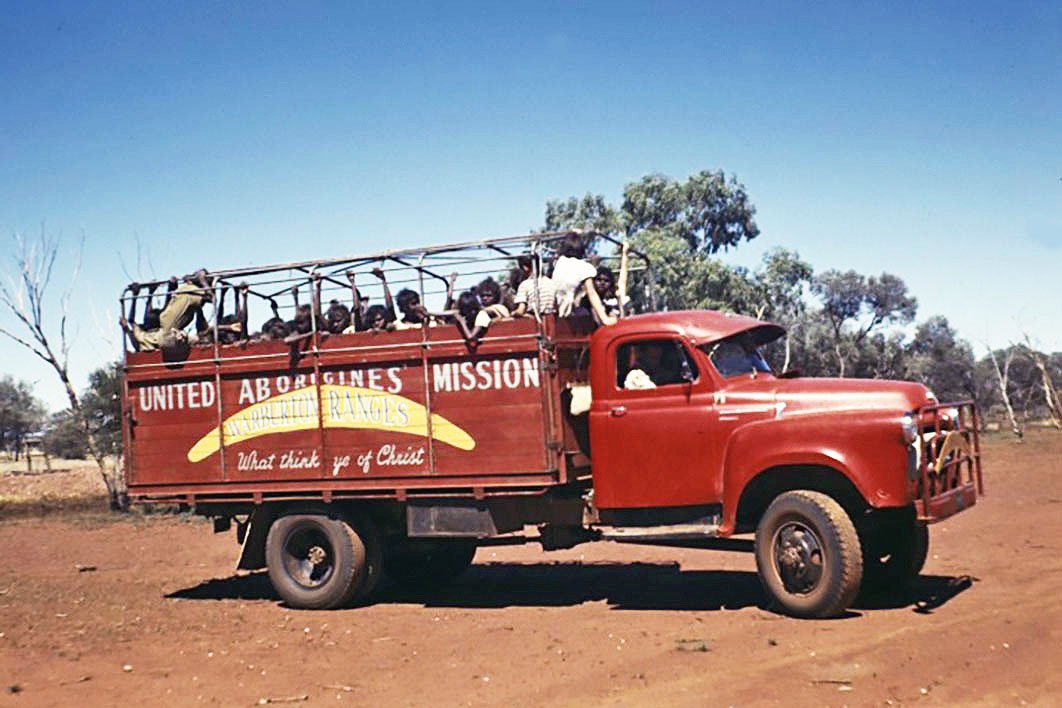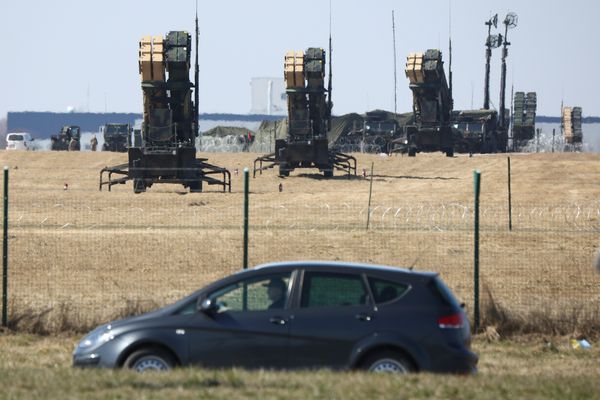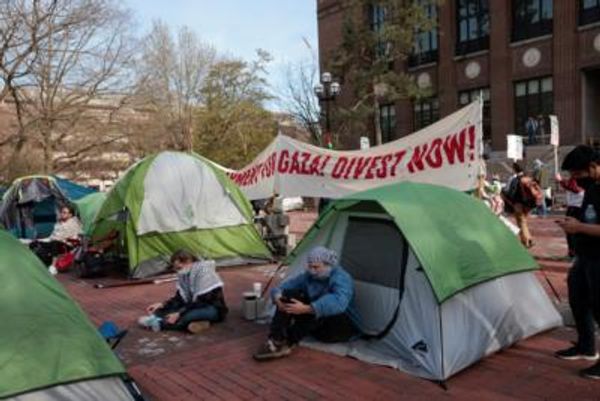
Lost amid the polarities of the Voice campaign was a more muted message: not only Labor but also the Coalition believes the gap will only be closed if governments listen to regional Voices. The referendum was defeated by a No campaign that included a promise by the Liberal Party to legislate Voices across the regions.
If these Voices are to be among the next government initiatives to deal with Indigenous disadvantage then we would be wise to study their history — for the idea is not new. For that reason, Max Angus’s new book, Too Far Out, an “administrative history” of the Ngaanyatjarra community of Western Australia, couldn’t be more timely.
The Ngaanyatjarra community — 1542 kilometres northeast of Perth, 750 kilometres northeast of Kalgoorlie, 560 kilometres northeast of Laverton, 1050 kilometres southwest of Alice Springs and (by my estimate) 2200 kilometres from Canberra — is remote from any recognised administrative centre. Imagine a London borough governed by officials living and working in Budapest with oversight from officials in Bucharest.
As a “nation for a continent” (in the words of Australia’s first prime minister) “remote” is what Australia does: assuming responsibility for all corners of this land is our sovereign project. Since the early twentieth century, the Ngaanyatjarra have become interlocutors of Australia’s three-level state; less and less are they “too far out.” They have been Australian citizens since 1948 (and British subjects before that). They have become literate in English, and were fully enfranchised in 1984. Many would call themselves Christian, and their homeland has been of intermittent economic significance. They have been statistically visible — on the wrong side of the gap — since the 1970s. How their homeland became a governable region is the story that Angus, a former professor of education, wants to tell.
Until 1873–74, when William Gosse, Ernest Giles and John Forrest began to map cross-continental routes, no European had entered the region. An imagined Laverton-to-Oodnadatta stock route would have passed through but it never came into existence; only in the early twentieth century did prospectors venture there and humanitarians begin considering how the denizens of this arid interior might be protected.
From South Australia’s Christians came a proposal, in 1914, to declare reserves — “sanctuaries” — on each side of the border with Western Australia. Would the Commonwealth join them in its adjacent southwest corner of the Northern Territory? After years of negotiation the three contiguous Central Australian Reserves were gazetted in 1920–21 and this “inviolable” region of interacting desert peoples came under three colonial authorities.
But officials in Perth, notionally responsible for the welfare of the Ngaanyatjarra, had no program and no knowledge. In the 1930s, from Mount Margaret Mission near Laverton, pastor Rod Schenk and schoolteacher Mary Bennett peered east and hoped that Perth would not license the Ngaanyatjarra homeland to graziers and gold-seekers. Motor cars were replacing camels but there were still no roads. The Ngaanyatjarra were reported to be “gentle and well mannered” and evidently “contented and well fed.”
The WA government refused tenure in the region to all but missionaries. After Schenk established a mission at the Warburton range, near the reserve’s western edge, in 1934, he persuaded the government to extend the reserve boundary further west to include a permanent Euro-Australian presence, the United Aborigines’ Mission under William and Iris Wade.
With the state stinting the money needed to feed the desert people attracted to the mission, Ngaanyatjarra people, encouraged by the Wades, began competing for the government bounty on dingo scalps with “doggers” already active in the Western Desert. The state government sought to regulate the mission’s scalp dealings, and in 1947 visiting police observed the Ngaanyatjarra hunters breeding dingos for scalp harvesting. (In the mid sixties, anthropologists began learning of a dingo dreaming track starting at a site known as Nanku.)
By then, Australian governments were imagining Indigenous Australians’ secular pathway to economically independent citizenship. Officials wondered if the mission was giving the Ngaanyatjarra enough to eat and whether it was right to house children in dormitories. Native affairs commissioner Stanley Middleton (1948–62) was committed to “assimilation,” even for the most distant and “primitive” people, but the policy raised a question: could a Christian mission on an inviolable reserve be an instrument of its residents’ progress?
Warburton mission’s government subsidy increased, but it was calculated on the assumption that many who frequented the mission were living as hunter-gatherers and dingo farmers rather than reliant on the mission. But the government began considering a plan to close the Warburton mission and transfer residents 200 miles to Cosmo Newberry, a settlement acquired by the missionaries in 1953 to train children with state government support. Warburton mission found an advocate in Bill Grayden MP, however, who persuaded the Legislative Assembly to set up an inquiry into the welfare of “natives” in the Laverton–Warburton Ranges region. Having found the people at Warburton to be in a depleted condition, the committee recommended that the government subsidise a pastoral enterprise for the Ngaanyatjarra.
A dispute ensued: visitors in 1957 (including a young Rupert Murdoch) debated how well or how badly off were the Ngaanyatjarra, what remedies they were entitled to, who was responsible for delivering assistance and whether English should replace Ngaanyatjarra as the region’s lingua franca. The records assiduously consulted by Angus suggest that the Ngaanyatjarra had no independent voice in these debates.
Meanwhile, the “inviolable reserve” was being subjected to excisions. The Commonwealth’s weapons testing program required it to establish an observation post within the reserve — Giles Weather Station, with connecting roads — and the WA government opened a third of the reserve (7500 square miles) to International Nickel of Canada in 1956. The Ngaanyatjarra thus became a “problem”: in order to protect them, authorities now had to exclude them from places where Commonwealth and company employees — in small numbers — were residing. Middleton hoped that the Commonwealth would assume responsibility for developing all of the Central Reserves; South Australia, for its part, initiated a pastoral enterprise at Musgrave Park, later known as Amata, in 1961.
To begin with, the Ngaanyatjarra are in the background of Angus’s story, but he is able to move them steadily to the foreground. The more their homeland was encroached on, the more their remaking of their life became visible to colonial authority and thus to the historian.
Some 450 residents were counted at Warburton in 1962. They were increasingly dependent on the food the mission provided. The following year a patrol officer reported that the Ngaanyatjarra were using their homeland’s recently graded tracks — even purchasing their own truck from sales of copper ore found near the mission. At this point it becomes possible for Angus to name individual Ngaanyatjarra.
A man called Tommy Simms had discovered the copper, and by 1961 the mission was managing the earnings derived by a small number of men from mining the ore and sending it to British Metals in Perth. The government wanted to develop the enterprise on a commercial footing, but the mission sought to defend its own interests and assure a degree of Ngaanyatjarra control. Western Mining offered to partner with the men, the government approved, and Simms became the first Ngaanyatjarra with the means to purchase his own vehicle (a Toyota and a Bedford truck).
In 1966 the government licensed Western Mining to prospect within the reserve and form partnerships with Simms and other individuals. Between forty and sixty men were involved in mining by 1967; in keeping with Western Desert people’s now well-known respect for “autonomy” within a continuously negotiated “relatedness,” those with tenements preferred individual partnerships with Western Mining to a cooperative. Others participated as employees. Would copper ore pave the way to the future governments hoped for?
But the Ngaanyatjarra easily disengaged from copper mining: the land was unevenly mineralised, the work was tedious, hunting remained an attractive alternative, and the mission would still feed them. “Their deep attachment was to the Ngaanyatjarra people and lands,” writes Angus, “not to a mining corporation or to a Western lifestyle.”
By the time Western Mining decided it was no long profitable to work with Ngaanyatjarra, one in ten Warburton residents had become eligible for the social security payments that now made up two-thirds of the community’s income. In 1969 the payments, previously made collectively, began being paid to individual recipients. The change was conceived and defended as a step towards “citizenship,” but it wrecked the mission’s system of communal provision.
Prospects of further income from the mining of nickel (around Wingellina) and chrysoprase had to be weighed against a growing official concern for the protection of sacred sites whose locations were being revealed to researchers during the 1960s by Ngaanyatjarra. They wanted income from mining, but in ways that respected country.
By this time, a new federal Office of Aboriginal Affairs was looking at how employment could be brought to the region in ways that aligned with local interests. An inquiry proposed that a new, federally funded Central Reserves Trust representing Ngaanyatjarra and neighbouring peoples would gradually assume control of the three reserves, re-establish Warburton mission as a planned township, develop tourism and horticulture, and permit Aboriginal prospecting. Before that happened, the Commonwealth demanded that Ngaanyatjarra land excised for mining be returned to the reserve. Western Australia complied in February 1972, while also amending its own legislation to allow a minister to approve exploration within the reserve.
Where did Warburton mission fit into this plan? Around Australia, Christian missions were relinquishing administration to Aboriginal councils. The WA government considered that its agencies — including the new (1972) Aboriginal Affairs Planning Authority — were better suited to administering Commonwealth investment in the reserves. The missionaries agreed, with misgivings, to confine themselves to “spiritual and linguistic” work. Administering the food supply — the children’s dining room and the store — devolved to Ngaanyatjarra, who were unprepared for the role. They were equally unprepared when a new Warburton Community Inc. introduced unfamiliar modes of governance in mid 1973. It was “a difficult period for all concerned,” writes Angus, but the policy of self-determination was politically irreversible.
For these policies and plans to work as “development,” much depended on which of the proliferating authorities and visitors the Ngaanyatjarra — the intended workforce and clientele — felt comfortable with. Visiting tradesmen were unfamiliar with the Ngaanyatjarra’s opportunistic approach to employment — intermittent and punctuated by spells on unemployment benefits. The local labour markets that worked in some Australian regions seemed not to apply in Ngaanyatjarra country. Teenagers rejected the daily discipline of school attendance and some residents refused to cooperate with nurses employed by the Australian Inland Mission. Blasting for the construction of a hospital upset the custodians of the Marla so much that visiting workers demanded police protection.
By 1975 Warburton was becoming known as a hostile environment for non-Ngaanyatjarra. For reasons cultural and logistical, it was proving difficult to police Warburton from Laverton. One of the Commonwealth’s responses was to assist Ngaanyatjarra to decentralise. The four resulting “homeland” communities — Wingellina, Blackstone, Warakurna and Jameson, each with its own white community adviser — were all places where Ngaanyatjarra had interacted with “whitefellas”: all were on the road network that prospectors and weapons researchers had created since the 1950s.
People from Docker River (a welfare settlement established in the Northern Territory in 1968) and Amata (a South Australian settlement established in 1961) also moved to the four communities. The Central Reserves were being repopulated using resources deliberately or inadvertently provided by a variety of non-Aboriginal intrusions. Their viability was based largely on welfare payments, as Angus writes, for the federal Department of Aboriginal Affairs “had given up pretending that some large-scale economic enterprise, leading to regular paid work, was just around the corner.”
As public health practitioner David Scrimgeour tells it in his recent book, Remote as Ever, a cohort of whites with relevant skills was emerging from southern capital cities to work alongside these Western Desert people. They believed that self-determination could work as long as it was re-spatialised according to Aboriginal wishes and resourced according to their rights as citizens. For Indigenous nations living almost entirely on imported food, the “smoothly operating well-stocked store” was each new community’s foundational institution. Schools and clinics (each with itinerant staff) followed. Able to move among Ngaanyatjarra’s five communities, people occupied their homeland with fewer material constraints; but it was difficult to service “communities” so transient.
The 1967 referendum had created the potential for intergovernmental relationships to change in ways that could work to the advantage of Ngaanyatjarra. The Commonwealth sought to treat the entire Central Reserve as a single “tri-state” object of reformed administration. Decisions in Canberra meant that the Ngaanyatjarra began to look more to the local Department of Aboriginal Affairs office in Alice Springs and less to state officials in Perth. WA government agencies increasingly faced demands from community advisers who answered to Canberra.
Empowering the Commonwealth at the expense of the states caused tensions among non-Indigenous officials. A major Commonwealth innovation in 1977 was to lump unemployment benefits into a single payment to each community — the Community Development Employment Projects, or CDEP, schemes.
When their expectations were not met, Ngaanyatjarra were sometimes violent towards service providers, making policing (where, how many, what methods) a policy issue in the late 1970s. Christian evangelism (including a “Christian Crusade” in 1981) and new by-laws in Warburton reduced but didn’t stop alcohol abuse and petrol-sniffing. Angus argues convincingly that outbreaks of “lawlessness” preceded the 1970s transition to “self-determination.” But the question remained: could the institutions of self-determination reduce the frequency and severity of such “turbulence”?
A certain level of turmoil did not stop the Ngaanyatjarra and their neighbours to the east from collective action using the Commonwealth’s and South Australia’s land rights policies. The formation of the Pitjantjara Council, the continuing interest of mining companies in the reserve’s nickel, and the pro-mining stance of WA premier Charles Court stimulated the formation of the Ngaanyatjarra Council in March 1981. In well-publicised lobbying, the council demanded inalienable freehold title to the WA portion of the Central Reserve.
An inquiry initiated by a subsequent premier, Labor’s Brian Burke, recommended in 1984 a way to legislate land rights. With claimable land amounting to 47.2 per cent of Western Australia’s total area, the Liberal Party argued, as it would in 2023, against “a set of rights which will be attributable to one small group of our population,” and it had the numbers in the Legislative Council to defeat Labor’s bill.
Burke’s government was impressed by the mining industry’s public relations campaign and lobbied for the Hawke government to abandon its planned national land rights bill. Would the Ngaanyatjarra accept a ninety-nine-year lease and the prospect of a nickel mining town (with jobs for Ngaanyatjarra) instead? The Ngaanyatjarra suggested that the government use existing legislation to lease the reserve land and other desired portions to a new body — the Ngaanyatjarra Land Council — some land portions with ninety-nine-year, others with fifty-year leases. Mining companies would apply to the land council, not the mines minister, for permission to explore, with a right to take any refusal to independent arbitration. Visitors could apply to the land council for permission to enter land under lease.
This 1988 deal, which Angus describes as “a masterfully executed compromise,” has lasted through several changes of government.
Because roads are an essential part of the Ngaanyatjarra’s adaptation, it mattered that, not being rate-payers, they could not vote in shire elections. When the franchise was extended to all adult residents, voter turnout among Ngaanyatjarra was much higher (40 per cent in May 1987) than among all other voters in the Shire of Wiluna, which extended to the west. Recognising that the shire was now two regions distinguished by need, revenue base, economic activity and cultural outlook, the WA government split the Shire of Wiluna in half and established the Shire of Ngaanyatjarraku in the eastern portion in July 1993.
This belated municipal enfranchisement of the Ngaanyatjarra was by then paralleled in the Aboriginal and Torres Strait Islander Commission, or ATSIC. Replacing the Department of Aboriginal Affairs in 1989, ATSIC was made up of elected regional councils with responsibility for certain Commonwealth programs. At first, ATSIC comprised sixty elected regional councils; after amalgamations for the second round of elections in December 1993, there were only thirty-five. Ngaanyatjarra objected to being amalgamated with neighbours to their west (Martu) and south (Spinifex mob) and took legal action against the electoral process that chose the Western Desert Regional Council. Their objection — not wanting to be represented by strangers — remains a familiar theme of Indigenous Australian politics. Warren Mundine — campaigning against the 2023 referendum — cited the Ngaanyatjarra as an ally in his critique of the Voice co-design process proposed by Marcia Langton and Tom Calma.
“By the mid-1990s,” Angus concludes, “the Ngaanyatjarra Council could justifiably claim that the region had become self-managing within the state and Commonwealth legal frameworks.” He lists formally incorporated enterprises (transport, stores) the Ngaanyatjarra have developed through collective action.
In an afterword, he briefly takes the story to the present. He condemns the Howard government (1996–2007) and its successors for modifying, then abandoning, the single most important financial basis of “self-management,” the CDEP. An older set of expectations regained authority in government and to some extent among the wider public: the Ngaanyatjarra would develop (must develop) into job-seekers (with “work-like habits”) despite their region still having almost no labour market (other than that provided by the CDEP).
In his valuable ethnography of the social and linguistic practices that have evolved within Ngaanyatjarra transactions with governments, The Dystopia in the Desert, former Ngaanyatjarra employee Tadhgh Purtill argues that the community, its advisers and distant public servants have tacitly agreed never to confront the tensions between the different practical senses of a word that all feel obliged to use: “development.”
Ethnography yields an account of something on which all governance rests: embedded, routinised ways of describing Ngaanyatjarra circumstances. As Purtill observes, talk and text can be seen as enacting a kind of political truce. That is, they shield the fantasy of remote Aboriginal assimilation from a reality test it could not survive. Purtill’s point of view is elusive; he seems, at times, to be a whistle-blower unmasking a systemic rort of public funds. Yet in his account of mutual complicities the reader can see an adaptive structure, a buffer against the ongoing (and potentially lethal) chaos that is settler colonial authority in its liberal democratic form.
Well advised and adept, the Ngaanyatjarra litigated against the smashing of the CDEP in 2021. They won a $2 million payment and a government promise to negotiate a new framework of public financial support. Angus concludes his book wondering how that will work out in a political system that equates centralised decision-making with administrative rationality. There is a Ngaanyatjarra voice, but it is nothing without an attentive listener. •
Too Far Out: An Administrative History of the Ngaanyatjarra Homelands
By Max Angus | Hesperian Press | $66 | 295 pages
The post Voices off appeared first on Inside Story.







